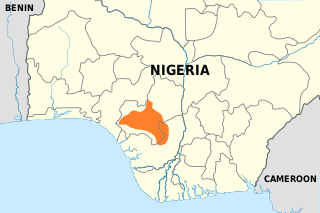Edo language: Difference between revisions
SyntaxTerror (talk | contribs) | map = Edo language.svg | mapcaption = Location of Edo speakers in Nigeria. |
SyntaxTerror (talk | contribs) | speakers = Nigeria : {{formatnum:2030000}} (2020)<br>Total : {{formatnum:2,031,670}} (ethnologue.com) |
||
| Line 7: | Line 7: | ||
| region = [[Edo State]] |
| region = [[Edo State]] |
||
| ethnicity = [[Edo people]] |
| ethnicity = [[Edo people]] |
||
| speakers = {{ |
| speakers = Nigeria : {{formatnum:2030000}} (2020)<br>Total : {{formatnum:2,031,670}} |
||
| date = |
| date = |
||
| ref = |
| ref = e25 |
||
| familycolor = Niger-Congo |
| familycolor = Niger-Congo |
||
| fam2 = [[Atlantic–Congo languages|Atlantic–Congo]] |
| fam2 = [[Atlantic–Congo languages|Atlantic–Congo]] |
||
Revision as of 21:13, 16 November 2022
| Edo | |
|---|---|
| Bini | |
| Ẹ̀dó | |
| Native to | Nigeria |
| Region | Edo State |
| Ethnicity | Edo people |
Native speakers | Nigeria : 2,030,000 (2020) Total : 2,031,670[1] |
| Latin | |
| Language codes | |
| ISO 639-2 | bin |
| ISO 639-3 | bin |
| Glottolog | bini1246 |
 Location of Edo speakers in Nigeria. | |
Edo /ˈɛdoʊ/[2] (with diacritics, Ẹ̀dó), colloquially called Bini (Benin), is a language spoken in Edo State, Nigeria. It is the native language of the Edo people and was the primary language of the Benin Empire and its predecessor, Igodomigodo.
Phonology
Vowels
There are seven vowels, /i e ɛ a ɔ o u/, all of which may be long or nasal, and three tones.
Consonants
Edo has a rather average consonant inventory for an Edoid language. It maintains only a single phonemic nasal, /m/, but has 13 oral consonants, /r, l, ʋ, j, w/ and the 8 stops, which have nasal allophones such as [n, ɲ, ŋʷ], and nasalized allophones [ʋ̃, j̃, w̃] before nasal vowels.
| Labial | Labiodental | Alveolar | Palatal | Velar | Labio-velar | Glottal | |
|---|---|---|---|---|---|---|---|
| Nasal | m | ||||||
| Plosive | p b [pm bm] |
t d [tn dn] |
k ɡ [kŋ ɡŋ] |
k͡p ɡ͡b [k͡pŋ͡m ɡ͡bŋ͡m] |
|||
| Fricative | f v | s z | x ɣ | ɦ | |||
| Trill | r | ||||||
| Close approximant | ɹ̝̊ ɹ̝ | ||||||
| Open approximant | ʋ [ʋ̃] |
l [n] |
j [ɲ] [j̃] |
w [ŋʷ] [w̃] |
The three rhotics have been described as voiced and voiceless trills as well as a lax English-type approximant. However, Ladefoged[3][page needed] found all three to be approximants, with the voiced–voiceless pair being raised (without being fricatives) and perhaps at a slightly different place of articulation compared to the third but not trills.
Phonotactics
Syllable structure is simple, being maximally CVV, where VV is either a long vowel or /i, u/ plus a different oral or nasal vowel.
Orthography
The Edo alphabet has separate letters for the nasalised allophones of /ʋ/ and /l/, mw and n:
| A | B | D | E | Ẹ | F | G | Gb | Gh | H | I | K | Kh | Kp | L | M | Mw | N | O | Ọ | P | R | Rh | Rr | S | T | U | V | Vb | W | Y | Z |
| /a/ | /b/ | /d/ | /e/ | /ɛ/ | /f/ | /ɡ/ | /ɡb/ | /ɣ/ | /ɦ/ | /i/ | /k/ | /x/ | /kp/ | /l/ | /m/ | /ʋ/ | /l/ | /o/ | /ɔ/ | /p/ | /r/ | /ɹ̝̊/ | /ɹ̝/ | /s/ | /t/ | /u/ | /v/ | /ʋ/ | /w/ | /j/ | /z/ |
Long vowels are written by doubling the letter. Nasal vowels may be written with a final -n or with an initial nasal consonant. Tone may be written with acute accent, grave accent, and unmarked, or with a final -h (-nh with a nasal vowel).
See also
References
- ^ Edo at Ethnologue (25th ed., 2022)

- ^ Laurie Bauer, 2007, The Linguistics Student's Handbook, Edinburgh
- ^ Ladefoged, Peter; Maddieson, Ian (1996). The Sounds of the World's Languages. Oxford: Blackwell. ISBN 0-631-19815-6.
- Emovon, Joshua A. (1979). A phonological study of Edo (Bini), with special reference to the verbal phrase. University of London, School of Oriental and African Studies (United Kingdom)
External links
- Edo Language Dictionary Online
- Hans Melzian's Edo-English Dictionary
- Rebecca Agheyisi's Edo-English Dictionary
- Centre for Edo Studies
- PanAfrican L10n page on Edo (Bini)
- Edo/Africa names dictionary{source Edoworld}
- Bini (Edo) wordlists and recordings at the UCLA Phonetics Archive
- Bini (Edo) Market Days Calender [sic] on Naija local
